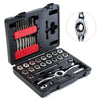
Why Anti-Static Tools are Crucial for Safe Computer Repair
When it comes to fixing computers, safety is key. One of the biggest risks is static electricity, which can cause serious damage to sensitive parts. Using anti-static tools, found in any good computer repair tool kit, is essential for anyone working in computer repair. This article will explore why these tools are important, the best ones to use, and how to keep your workspace safe from static discharge.
Key Takeaways
-
Static electricity can harm computer parts, so it's important to use anti-static tools.
-
Wrist straps, mats, and bags are essential tools for preventing static damage.
-
Always wear an anti-static wrist strap when working on computers to stay safe.
-
Set up your workspace with anti-static mats to protect your equipment.
-
Regularly check and maintain your anti-static tools to ensure they work properly.
Understanding the Importance of Anti-Static Tools

The Science Behind Static Electricity
Static electricity is a common phenomenon that occurs when there is an imbalance of electric charges on the surface of objects. This can happen easily in dry environments or when certain materials rub against each other. Understanding how static builds up is crucial for anyone working with sensitive electronics.
Common Sources of Static in a Repair Environment
In a computer repair setting, static can come from various sources, including:
-
Synthetic materials like carpets and clothing.
-
Movement of tools and components across surfaces.
-
Low humidity levels that increase static buildup.
Potential Damage from Static Discharge
Static discharge can cause serious harm to electronic components. Here are some potential damages:
-
Data loss from corrupted memory chips.
-
Component failure leading to costly repairs.
-
Reduced lifespan of devices due to unseen damage.
Maintaining a static-free environment is essential for protecting sensitive electronics.
Using anti-static tools is vital for creating a safe working environment and enhancing the reliability of the repair process by minimizing the risk of static damage. These tools help ensure that both the technician and the equipment remain safe during repairs.
Essential Anti-Static Tools for Your Computer Repair Tool Kit
When working on computers, having the right tools is essential for preventing damage. Anti-static tools are a must-have in any technician's toolkit. Here are some key tools you should consider:
Anti-Static Wrist Straps
-
Purpose: These straps help to ground you, preventing static electricity from building up.
-
Usage: Always wear it when handling sensitive components.
-
Types: Look for adjustable straps for comfort.
Anti-Static Mats and Workstations
-
Function: These mats provide a safe surface to work on, reducing static buildup.
-
Features: They often come with grounding points to connect your wrist strap.
-
Placement: Ensure your workstation is in a low-static area.
Anti-Static Bags and Containers
-
Protection: These bags keep components safe from static damage during storage.
-
Variety: Available in different sizes for various components.
-
Labeling: Always label your bags to avoid confusion.
Using the right anti-static tools can save you from costly repairs and component replacements.
In summary, having these essential anti-static tools in your computer repair kit can significantly reduce the risk of static damage. Make sure to invest in quality items to ensure the safety of your repairs.
How to Properly Use Anti-Static Tools
Correct Usage of Anti-Static Wrist Straps
To ensure safety while working on computers, it’s essential to use anti-static wrist straps correctly. Here are the steps to follow:
-
Put on the wrist strap snugly around your wrist.
-
Connect the strap to a grounded surface, like a metal part of the computer case.
-
Make sure the strap is in contact with your skin for effective grounding.
Setting Up an Anti-Static Workstation
Creating a safe workspace is crucial. Here’s how to set up an anti-static workstation:
-
Use an anti-static mat on your work surface.
-
Ensure that all tools and components are placed on the mat.
-
Keep the area clean and free from clutter to avoid accidental static build-up.
Storing Components in Anti-Static Bags
When you finish working, proper storage is key. Follow these tips for using anti-static bags:
-
Always place sensitive components in anti-static bags immediately after use.
-
Label the bags clearly to avoid confusion.
-
Store the bags in a cool, dry place to prevent moisture damage.
Remember, handling all electrostatic sensitive components in a static-safe area is vital. If possible, use anti-static floor pads and workbench pads to enhance safety.
Real-World Examples of Static Damage
Incidents of Static Damage in Professional Repairs
Static electricity can cause significant harm in computer repair settings. Five expensive losses due to static electricity have been documented, showcasing the serious risks involved. Here are some notable examples:
-
Data Loss: Static discharge can erase or change data on magnetic media.
-
Component Damage: Integrated circuits can suffer burn holes, leading to costly replacements.
-
Circuit Board Destruction: Entire circuit boards can be rendered useless due to static shocks.
Lessons Learned from Static Discharge Failures
From these incidents, several lessons can be drawn:
-
Always use anti-static tools during repairs.
-
Educate staff about the dangers of static electricity.
-
Regularly check and maintain anti-static equipment.
Preventative Measures in High-Risk Environments
To avoid static damage, consider implementing these strategies:
-
Set up anti-static workstations with proper mats and wrist straps.
-
Store sensitive components in anti-static bags.
-
Conduct regular training sessions for all repair personnel.
Preventing static damage is not just about tools; it’s about creating a culture of safety in the workplace.
Related Article: Magnetic vs. Non-Magnetic Tools: Which Are Better for Computer Repair?
Best Practices for Maintaining an Anti-Static Environment
Regularly Testing Anti-Static Equipment
To ensure that your anti-static tools are effective, regular testing is essential. Here are some key points to consider:
-
Check wrist straps for proper grounding.
-
Test mats for resistance levels.
-
Inspect bags for any signs of wear.
Training Staff on Anti-Static Protocols
Educating your team on anti-static practices is crucial. Consider these training tips:
-
Conduct workshops on the importance of static control.
-
Provide hands-on training with anti-static tools.
-
Share computer repair safety tips to reinforce best practices.
Creating a Static-Free Workspace
A well-organized workspace can significantly reduce static risks. Follow these steps:
-
Keep the area clean and free of clutter.
-
Use anti-static mats on work surfaces.
-
Ensure that all equipment is properly grounded.
Maintaining a static-free environment is not just about tools; it’s about creating a culture of safety and awareness.
By implementing these best practices, you can protect sensitive components and enhance the overall safety of your repair environment.
Anti-Static Measures for Electronics
Using anti-static tools is essential for anyone working on computers. These tools help prevent damage from static electricity, which can harm sensitive parts inside your devices. By taking simple steps, like using anti-static wrist straps and mats, you can keep your equipment safe and running smoothly. Remember, protecting your computer parts is just as important as fixing them. So, always make sure to use the right tools to ensure a safe and effective repair process.
Related Article: Computer Tool Kit Guide: Everything You Need to Know



